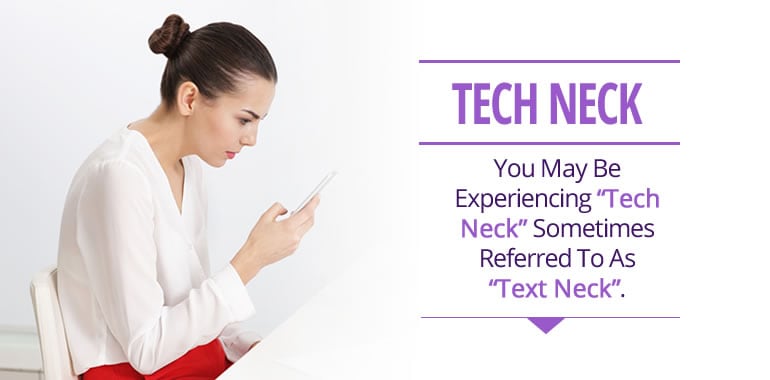
You may be experiencing “tech neck” sometimes referred to as “text neck”. While this is not an official medical diagnosis it is commonly characterized as a repetitive stress injury believed to be caused by excessive use of technology (computers and handheld electronic devices like your phone). The muscles, tendons, and ligaments of the neck are meant to support 10-12 pounds of head weight when the spine is in a neutral position. Commonly when texting the head is bent forward 45-60 degrees while looking down at the screen. This severe downward angle increases the weight load and forces places on the neck to approximately 45-60 pounds. Overtime these increased loads placed on the neck become so great that one may experience pain, limited range of motion, and even changes in the structure of the cervical spine.
Pain may be localized to the neck or more broadly in the neck, upper back, and into the shoulders. It may be a mild achiness or sharp, stabbing pain that is intermittent in the beginning but becomes more constant without intervention. The posture one assumes when texting tends to draw the head forward and down and round the shoulders in when using both thumbs to text or hold the phone This posture causes the deep neck flexors and pectoralis muscles in the front of the trunk to become shortened and tight while the muscles in the upper back have now adaptively lengthened and weakened. These muscular imbalances result in pain and restricted mobility of the neck, upper back, and shoulders.
One may also experience muscular pain at the base of the neck due to this posture that causes headaches. Excessive amounts of time spent looking at screens also increases the risk of headaches, migraines, and eyestrain. Other less common symptoms include cervical radiculopathy due to nerve root irritation, balance issues secondary to postural changes, and even jaw pain.
What Can You Do?
The first step you can take is to improve your postural awareness and habits when utilizing handheld devices or sitting at your desk/computer.
- 1Chin tucks: Stand in front of a mirror with shoulders relaxed. Gently pull your chin back to make a double chin. Do not tilt your head forward or backwards. Hold for 5 seconds and perform 10 times.
- 2Scapular retractions: sitting or standing with good posture, bend elbows to 90 degrees keeping shoulders relaxed. Try to touch elbows behind your back while squeezing your shoulder blades together. Hold 5 seconds and perform 10 times.
- 3Deep neck flexors stretch: Close your teeth without clenching. Gently extend your head back as far as you can. Open your mouth and try to tip your head back a little further. Now slowly close your mouth feeling a stretch through the front of your neck. Hold 5 seconds and perform 10 times.
- 4Doorway pec stretch: Stand in a lunge through a doorway. Bring your arms up to make a “W’ placing forearm on the door facings. Gently lean forward into the front foot until you feel a stretch across the front of your shoulders. Hold 15-20 seconds and perform 3 times.
Finally!
If all of these suggestions do not provide a significant reduction in your “tech neck” symptoms, it may be time to seek the help of one of our highly skilled physical therapists at BREAKAWAY PHYSICAL THERAPY. We will provide you with individualized and one-on-one care including manual therapies such as soft tissue mobilization, myofascial release, and joint mobilizations. We will recommend ergonomic changes to your work place set-up to reduce strain on your neck and back throughout your day and tailor a home stretching and strengthening program to ensure your symptoms do not return. Unsure of whether a full evaluation is right for you? Call 410-721-6333 to schedule a FREE 30-minute Breakthrough visit and speak to one of our physical therapists to help you make the best decision that works for you.




